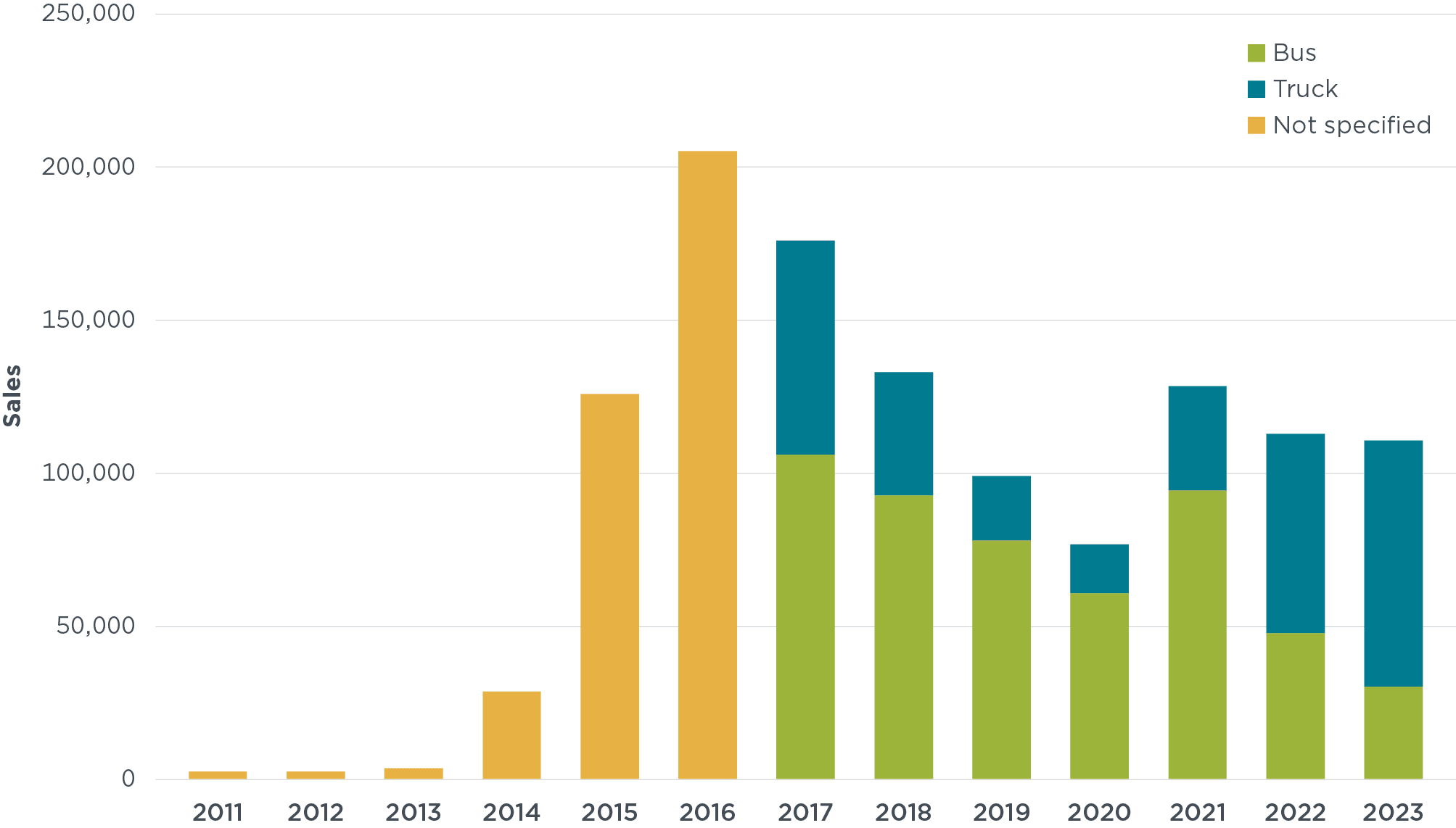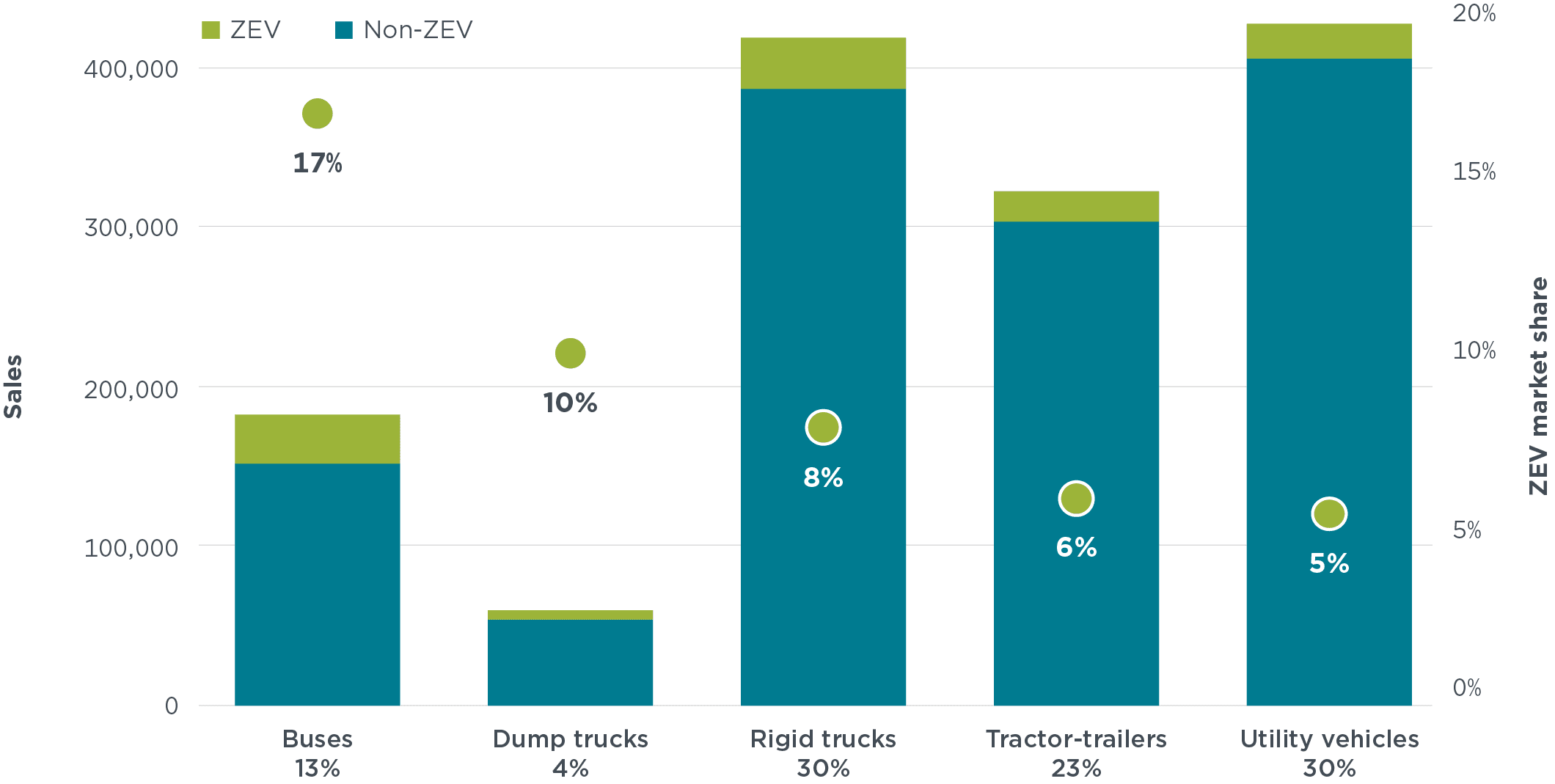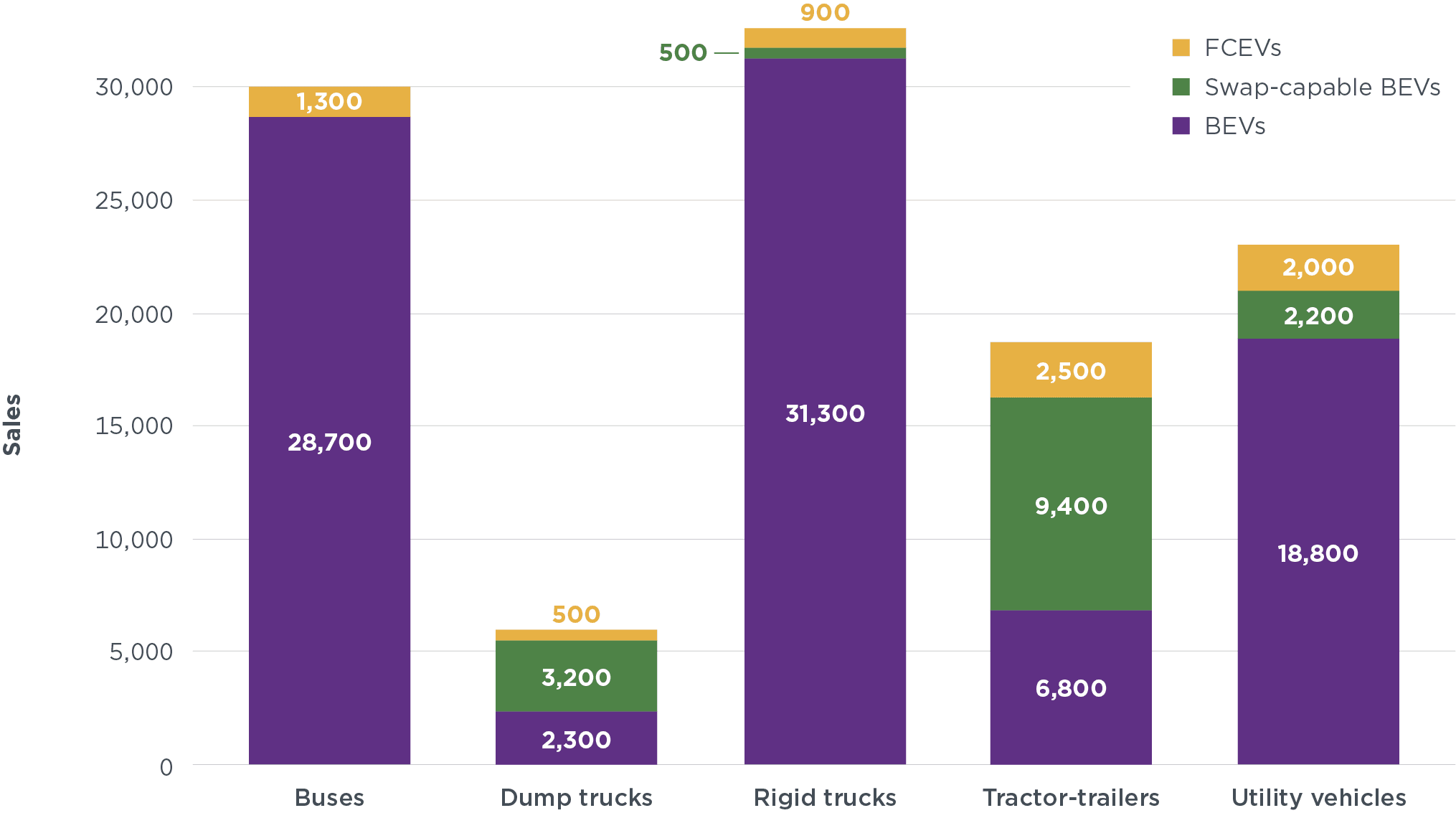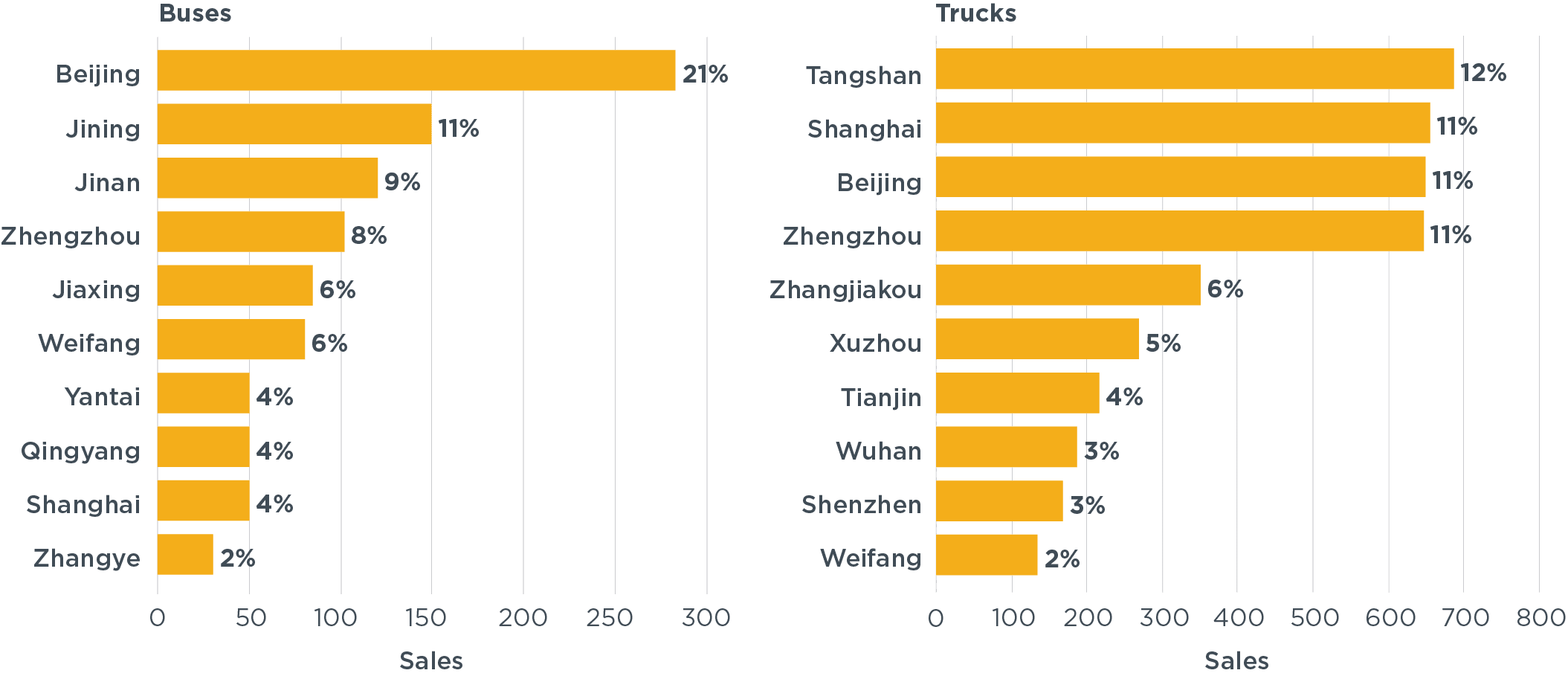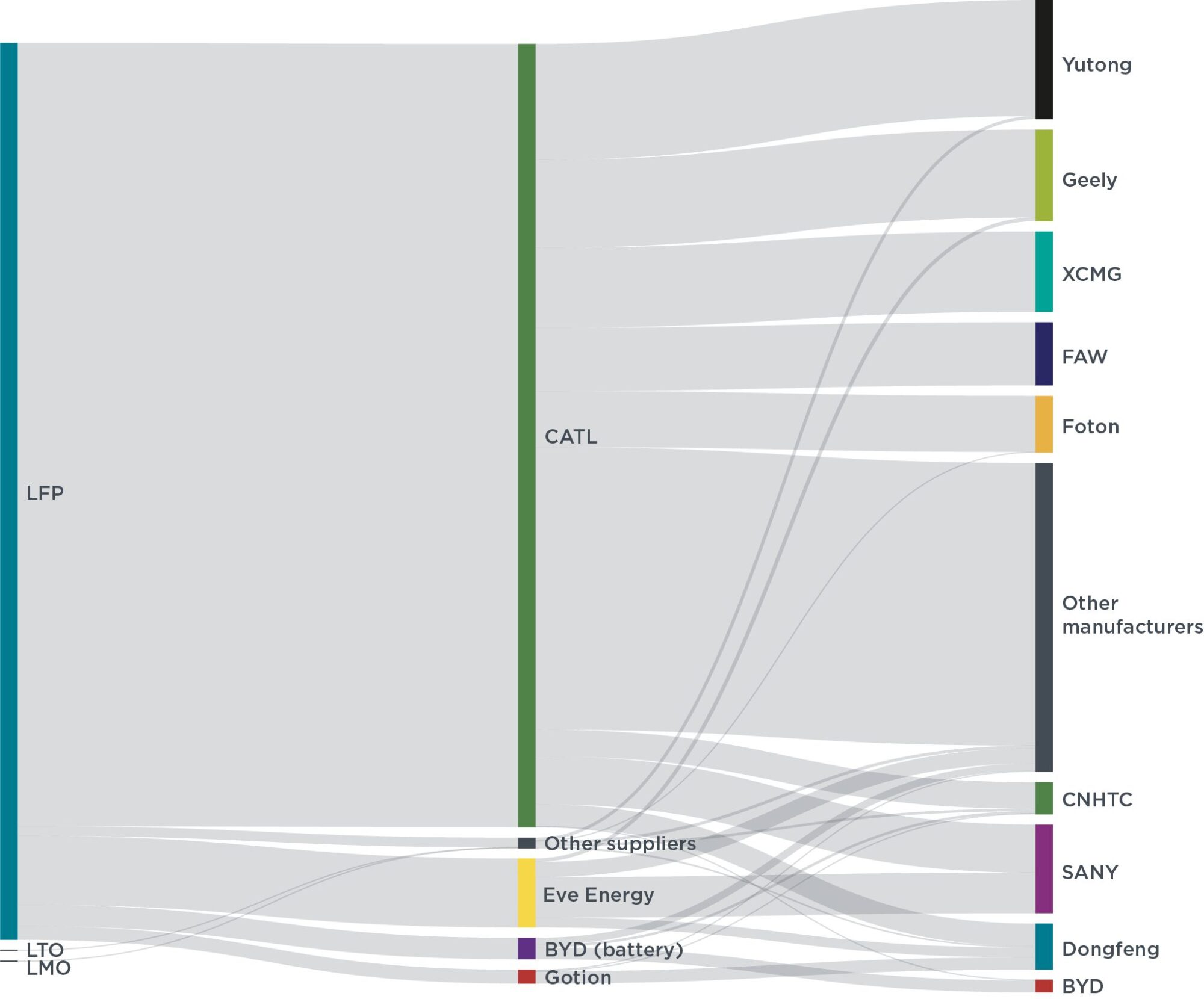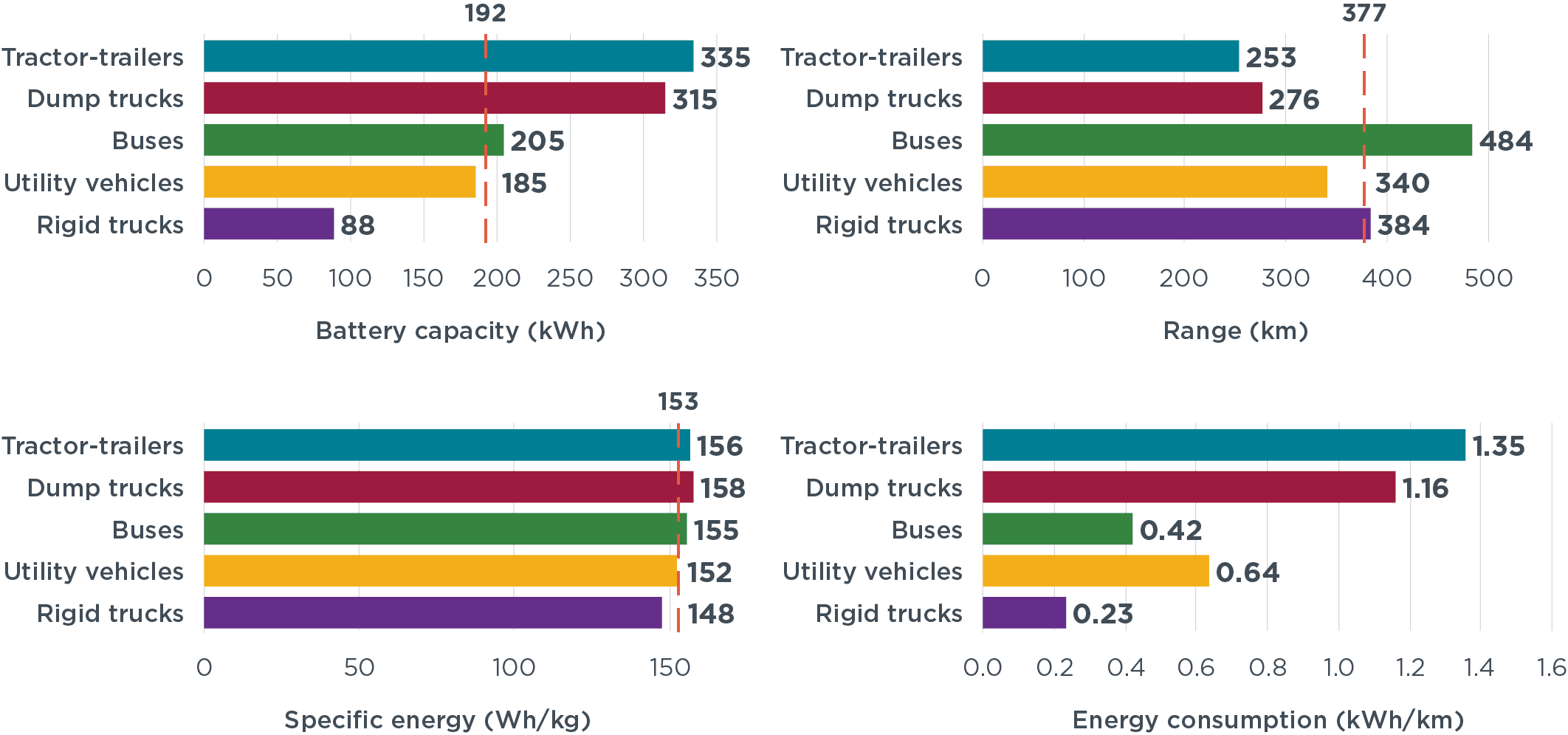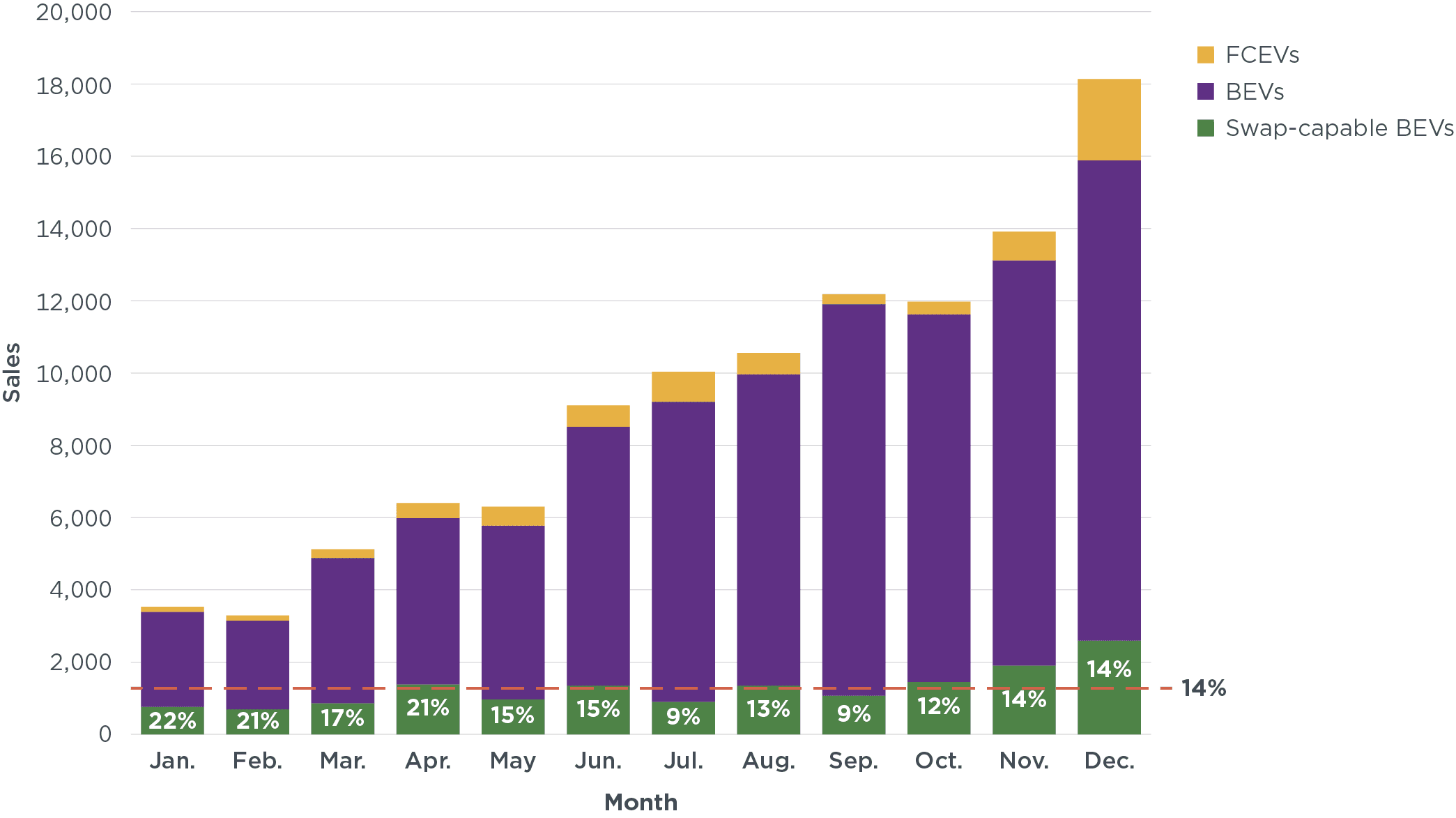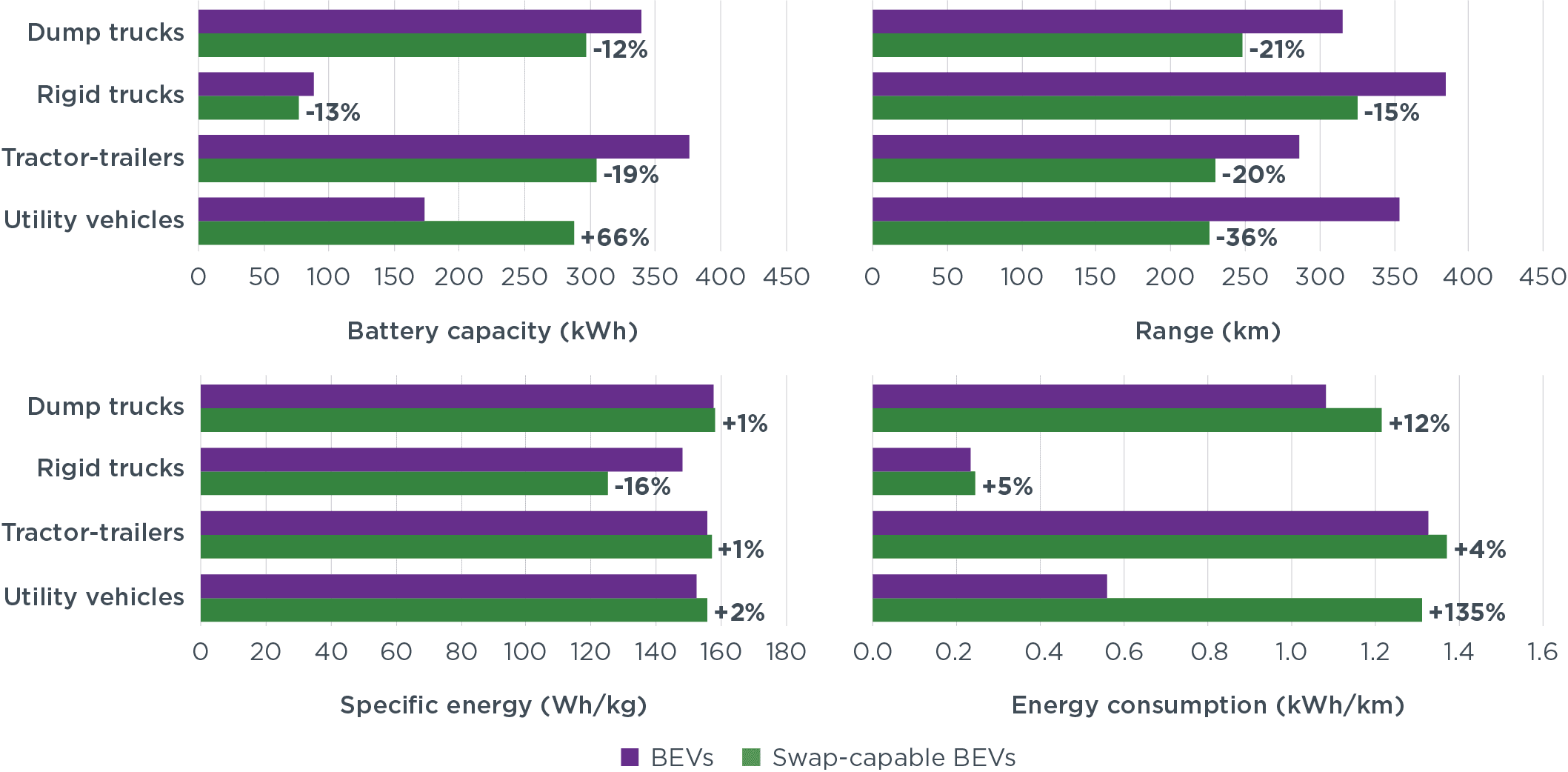Market Spotlight
Race to zero: Zero-emission bus and truck market in China in 2023
Sales and market share
This spotlight presents an overview of the 2023 market for new zero-emission heavy-duty vehicles (ZE-HDVs) in China, covering buses, heavy and medium rigid trucks, and tractor-trailers above 3.5 metric tons.
In 2023, total sales of ZE-HDVs decreased by 2% to 110,400 units, down from 113,000 units in 2022. New sales of ZE buses contracted, while those of ZE trucks increased. Meanwhile, the overall HDV market in China grew by 15% in 2023 compared with sales in 2022. The resulting market share of new ZE-HDVs in 2023 was 8%, compared with 9% in 2022. Despite this slight decrease for HDVs, the overall sales share of zero-emission commercial vehicles, including light-commercial vehicles, continued to increase.
Figure 1. Sales of zero-emission heavy-duty vehicles in China from 2011 to 2023
🔍 Click on the figures to take a closer look at the data
Figure 2. Zero-emission sales share of heavy-duty vehicles by segment, 2023
Notes: Percentages under the green circles refer to the market share of ZE-HDVs within each segment and correspond to the secondary axis. Percentage values below the columns refer to each segment’s share of total HDVs sold in 2023.
In 2023, battery electric vehicles (BEVs), swap-capable BEVs, and fuel-cell electric vehicles (FCEVs) comprised 80%, 14%, and 6% of new ZE-HDV sales, respectively. Sales of swap-capable BEVs and FCEVs reached 15,200 and 7,200 units, respectively— increases of 27% and 57% from 2022. BEVs remained the primary technology pathway for buses, rigid trucks, and utility vehicles, and swap-capable BEVs remained the leading technology for dump trucks and tractor-trailers.
The largest deployments of swap-capable BEVs and FCEVs were in the tractor-trailer segment, driven by increased adoption of these technologies for longer distance travel and a 2020 performance rating policy requiring low-emission transportation for 80% of bulk materials in select regions for pollution control (see “Definitions, data sources, methodology, and assumptions”). Approximately 92% of FCEV tractor-trailers and 64% of swap-capable BEV tractor-trailers were sold in regions covered by this provision. The ZE-HDV utility segment saw growing shares of swap-capable BEVs (10% of ZE utility vehicle sales, from 7% in 2022) and FCEVs (9%, from 8%). Concrete mixer trucks led among swap-capable BEVs in the utility segment, while refrigerated and insulated trucks led among utility FCEVs.
Manufacturers
Figure 4. Top ten zero-emission bus and truck manufacturers, 2023
Note: Data labels show market share of each manufacturer among total sales in each vehicle segment.
Cities
In 2023, 39% of battery electric bus sales and 53% of battery electric truck sales were concentrated in the top ten cities, by sales, for each segment. Shenzhen, Shanghai, Chengdu, and Beijing ranked among the top ten cities in terms of sales in both vehicle categories. Cities in China have deployed various strategies to accelerate zero-emission truck uptake. For instance, since 2021, Tangshan—which has major ports and is a hub for the iron and steel industries—has been a pilot city in the national program for developing swap-capable trucks. Chengdu has promoted the adoption of ZE engineering and dump trucks through such means as preferential road access. Six of the top 10 cities for ZE bus and truck sales are in regions subject to the pollution control measures noted above.
Figure 5. Top ten cities in sales of battery electric buses and trucks, 2023.
Note: Data labels show the market share of each city in national sales of battery electric buses (left) and trucks (right). There were no swap-capable battery electric bus sales in 2023.
The ten cities with the highest fuel-cell electric bus and truck sales in 2023 accounted for 75% and 68% of each market, respectively. In 2020, the national government launched a pilot program for the demonstration of FCEVs in cities; five city clusters—Beijing-Tianjin-Hebei, Shanghai, Guangdong, Hebei, and Henan—have since been selected for the initiative. In 2023, six of the top 10 cities for fuel-cell electric bus sales and eight of the top 10 cities for fuel-cell electric truck sales were part of these FCEV pilot clusters. Among non-pilot cities, Jining and Jinan, the second- and third-largest fuel-cell electric bus markets, are both in Shandong Province, which has been a demonstration province for research and application of hydrogen since 2021. Jinan is also home to the headquarters of CNHTC (also known as Sinotruk), a major HDV and ZE-HDV manufacturer. The top four cities for fuel-cell electric truck sales remained the same as in 2022.
Figure 6. Top ten cities in sales of fuel-cell electric buses and trucks, 2023
Note: Data labels show the market share of each city in national sales of fuel-cell electric buses (left) and trucks (right).
Battery technology and performance metrics
Lithium iron phosphate (LFP) remained the dominant battery chemistry in the ZE-HDV industry in 2023, representing 99.9% of battery capacity in new ZE-HDV sales, a slight increase from 99.4% in 2022. The remaining 0.1% comprised lithium-ion manganese oxide (LMO) and lithium titanate oxide (LTO) batteries produced by smaller battery suppliers.
The battery supplier market continued to consolidate in 2023. Contemporary Amperex Technology Co. Ltd. (CATL)’s market share grew from 79% in 2022 to 87% in 2023. Correspondingly, the market share of smaller suppliers decreased. Vehicle manufacturers such as Yutong and XCMG predominantly sourced from one battery supplier, while others such as CNHTC and Dongfeng sourced from a variety of suppliers.
Figure 7. Zero-emission HDV battery chemistry, battery supplier, and manufacturer sourcing of batteries in 2023
Notes: Width of links is proportional to each battery technology’s relative share of battery capacity in new ZE-HDVs sold in 2023. Figure made using data from top vehicle models by 2023 sales, which accounted for over 75% of new vehicle sales in 2023.
Figure 8. Sales-weighted average type-approved battery capacity, range, specific energy, and energy consumption by segment, 2023
Notes: Reference lines and corresponding data labels show the sales-weighted average for all ZE-HDVs. A sales-weighted average reference line is not shown for energy consumption, which is largely determined by vehicle weight. Values are rounded to two significant digits for energy consumption and three for all other metrics.
Battery swapping technology
Swap-capable BEVs reached a 14% penetration rate in new ZE-HDV sales in 2023. As of June 2023, there were about 400 battery swapping stations for trucks in China.
Figure 9. Monthly zero-emission heavy-duty vehicle- sales by technology, 2023
Notes: White data labels indicate average monthly swap-capable HDV market shares. The grey reference line and corresponding data label indicate average annual swap-capable vehicle market share.
Across all segments, swap-capable BEVs displayed lower ranges and higher per-kilometer energy consumption than their non-swap-capable BEV counterparts. Moreover, with the exception of utility vehicles, BEVs had higher battery capacity than swap-capable BEVs across all vehicle categories. These differences are in part due to the different use cases for the two technologies. Concrete mixers and garbage trucks—heavy vehicles that require large batteries and high energy consumption—accounted for almost 95% of new swap-capable utility vehicles in 2023. Only about 22% of new battery electric utility vehicles were used for purposes that consume more energy than either of these two applications.
Swap-capable trucks usually have lower specific energy than their BEV counterparts. This can be attributed to the energy penalty associated with the weight of the frame surrounding the battery, which is relatively higher for smaller, swap-capable batteries. The slightly higher specific energy for swap-capable BEVs in segments other than rigid trucks reflects the use of BEVs in a greater range of applications requiring comparatively lower specific energy than swap-capable BEVs.
Figure 10. Comparison of sales-weighted average battery capacity, nominal range, specific energy, and energy consumption of battery electric and swap-capable heavy-duty vehicles in 2023
Note: Data labels show percent difference compared to BEVs.
Looking beyond 2023
Definitions, data sources, methodology, and assumptions
A zero-emission vehicle is any vehicle whose propulsion system produces zero combustion emissions, such as a dedicated battery-electric, fuel-cell electric, or other motor that is not driven by combustion.
A heavy-duty vehicle is a commercial vehicle intended for the transport of passengers or freight with a gross vehicle weight above 3.5 tonnes.
Utility vehicles are vehicles mostly designed for specific purposes, such as sanitation, refrigeration, and engineering.
Regions covered by the 2020 performance rating policy include the provinces of Hebei, Shanxi, Shanghai, Zhejiang, Jiangsu, Anhui, Shandong, Henan, and Shaanxi, and the cities of Beijing and Tianjin. The 2023 Clean Diesel Action Plan expands this policy to other regions, with a bulk material low-emission transportation requirement of 70%.
Data sources: Sales data for 2023 were provided by Gasgoo. The sales data exclude imports and exports. Imported HDVs would account for around 1% of HDV sales in 2023, assuming all imports were sold in 2023. Import data are from the General Administration of Customs of the People’s Republic of China, http://stats.customs.gov.cn/. Battery chemistry and supplier data are from Ministry of Industry and Information Technology’s new energy vehicle purchase tax exemption catalogue, while type-approved range, battery capacity, and specific energy are from the Ministry ‘s Product Catalogue of Recommended Models for the Promotion and Adoption of New Energy Vehicles. Type-approved energy consumption is calculated from range and battery capacity. The number of battery swapping stations for trucks is from Tsinghua University’s Institute for Internet Industry, “Battery swapping standardization helps the development of China’s electric vehicle industry [blog post],” June 25, 2023, https://www.iii.tsinghua.edu.cn/info/1131/3464.htm.
